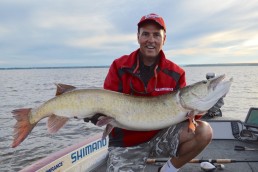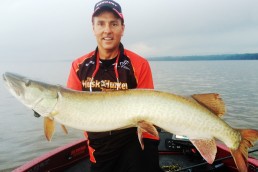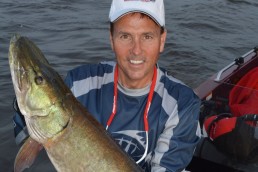SHARE THIS POST
Don’t Overthink It
I have been muskie fishing a long time and have written and read a lot of articles about early-season muskies. The more I fish for them, the more I realize there are no hard-and-fast rules. However, you have to make assumptions or hypotheses, and test them to see if you are correct. Those assumptions may be anything from the spot where the fish might be located to the actual lure that will catch them. I do this for a living, and half the time I guess wrong! Now, that doesn’t mean I won’t make a quick adjustment; it’s just that muskies don’t read magazines or watch television shows. Muskies are a byproduct of their environment. They are thoroughly aware of their environment and react to multiple conditions and situations. Muskies don’t learn like humans; rather, they react from experiences. However, here are some early-season muskie strategies that have proved the test of time.
If you think too hard about all of this, muskie fishing can seem very complex, but it really isn’t. In fact, if you keep it simple, you’ll often be more successful. The number one obstacle most weekend warriors face is over-thinking the situation. It’s great to have a game plan, but let the conditions evolve and let muskies tell you what they want. Let’s consider some early season fundamentals and how more than one approach can produce fish.
The Factors
When you think about early-season muskies, what are the first few thoughts that come to mind? I bet many of you thought shallow water, warm water, cover and baitfish. Those are all correct answers. Shallow water warms the fastest, usually has remnant cover or newly emergent cover, and therefore is a secure area for baitfish. Therefore, it is a natural area to hold early season muskies.
One of the first key areas to check in early season is shallow bays, and shallow channels. One thing I have learned about these areas is not to get too precise. The muskies can be roaming anywhere on these large flats, bays or channels. So, you are better off systematically drifting these areas. You’ll find pockets of weed growth, maybe a subtle depth depression or rise, or just maybe a spot holding a pack of muskies. In either case, mark the spot with your GPS and work it thoroughly. Try different casting angles and different lures. Those fish won’t move far; they just feed at infrequent times throughout the day. So, the angler that camps on these spots most of the day is often rewarded.
Having just told you the merits of shallow muskies in early season, then why are so many muskies also caught suspended over open water during the same time? Again, muskies are individuals. Also, some muskies, once they finish spawning, quickly return to the security of the basin, as the shallow cover isn’t as developed at this time. So, the open water basin is a natural safe haven for muskies. Of course, don’t forget that suspended forage exists in many waters, and that the muskies don’t need to feed on shallow-water forage if there is an abundance of open-water forage such as ciscoes or shad.
Where to Concentrate
Concentrate on the basins in early season and catch muskies. Try to locate muskies suspended a couple casts from the largest structural element or potential spawning area. Also, use your electronics to locate large schools of bait. At this time, the bait is shallow and so are the muskies. So, using lures that run in the top 10 feet of the water column is usually best.
Are you enjoying this post?
You can be among the first to get the latest info on where to go, what to use and how to use it!
When you start the day, remember the muskies may be in the shallow bays or channels, but they may be equally suspended. So, make an educated guess. I’ll base my decision on the local weather conditions the evening before I am going fishing, and of course that morning. Cold nights and cold mornings will have me focusing on the basin, as those muskies tend to be less affected by the drop in surface temperatures associated with cool nights and mornings. If the basins aren’t working, I’ll check the channels later that morning or early afternoon when the surface temperatures start to rise.
On the contrary, if the morning is warm and possibly overcast, I’ll check the shallows, as those fish could be going crazy from the start. One thing is for sure: If there is a group of muskie anglers in the same area and no one is catching anything in an hour or so, it’s time to leave. Not that they can’t turn on and start biting, but more often than not, the fish just aren’t active, and you are better off looking for something else.
Experiment
One thing is certain in early season muskie fishing: Conditions are constantly changing, and there is usually more than one way to catch them, so don’t be afraid to experiment. If you make assumptions to help guide you throughout the day, you’ll be much more successful than trying to only follow hard-and-fast rules.
Become a MidWest Outdoors Insider here!
MWO
SHARE THIS POST
Did you enjoy this post?
You can be among the first to get the latest info on where to go, what to use and how to use it!
Jim Saric
Jim Saric is a Legendary Angler in the Freshwater Fishing Hall of Fame, the host and executive producer of The Musky Hunter television series, editor at large of Musky Hunter magazine, a seven-time muskie tournament winner, and a contributing writer for numerous other publications.



